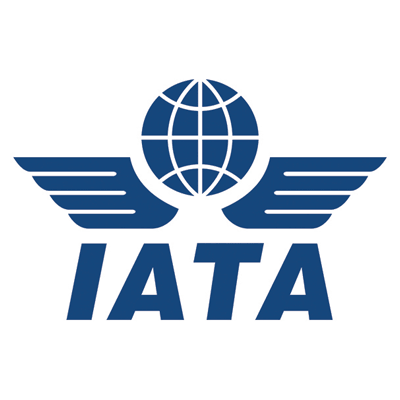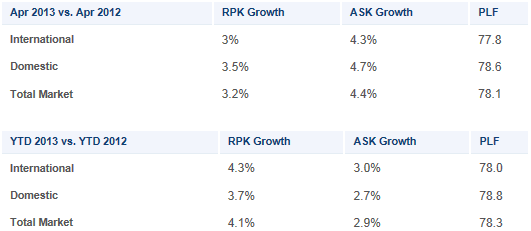Strong passenger growth trend continues
- Like
- Digg
- Del
- Tumblr
- VKontakte
- Buffer
- Love This
- Odnoklassniki
- Meneame
- Blogger
- Amazon
- Yahoo Mail
- Gmail
- AOL
- Newsvine
- HackerNews
- Evernote
- MySpace
- Mail.ru
- Viadeo
- Line
- Comments
- Yummly
- SMS
- Viber
- Telegram
- Subscribe
- Skype
- Facebook Messenger
- Kakao
- LiveJournal
- Yammer
- Edgar
- Fintel
- Mix
- Instapaper
- Copy Link
Posted: 3 July 2013 | IATA | No comments yet
IATA announced global passenger traffic results for May showing that air travel continued to expand at a healthy rate…


The International Air Transport Association (IATA) announced global passenger traffic results for May showing that air travel continued to expand at a healthy rate. Growth was led by emerging markets. Compared to the year-ago period, overall demand rose 5.6%, while capacity climbed 5.2% pushing the load factor up 0.3 percentage points to 78.1%.
“Global economic performance remains a concern; however, demand for air travel continues to expand. The primary driver is growing demand for connectivity to emerging markets. The business environment has also improved compared to mid-2012 with some indications of easing weakness in the Eurozone. It’s still a tough environment, but there are some reasons for optimism in the second half of the year,” said Tony Tyler, IATA’s Director General and CEO.


International Passenger Markets
May international passenger demand rose 5.7% compared to the year-ago period, with capacity up 5.6%. Load factor was flat at 77.0%. The strongest growth occurred in the emerging markets of Africa, Latin America and the Middle East.
- European carriers recorded 5.6% growth on international services compared to May 2012. The underlying growth trend has also picked up, suggesting that improving consumer and business confidence in Europe could be supporting stronger growth in air travel demand. Capacity growth of 4.4% meant that load factor climbed 0.9% percentage points to 79.1%, the second highest among the regions.
- Asia-Pacific airlines’ international traffic rose 3.7% in May compared to the year-ago period but this was more than offset by a 5.5% rise in capacity with the result that load factor slipped 1.3 percentage points to 74.1%. The softness in demand is consistent with falls in business confidence in major Asian economies as well as a slowdown in trade growth momentum. In particular GDP growth in China did not meet expectations in the first quarter and business confidence has slipped to levels indicating contraction in manufacturing activity.
- North American airlines’ international traffic climbed 3.0% in May versus May 2012. This was the slowest rise among the regions but with capacity up just 1.7%, load factor rose 1.1 percentage points to 83.4%, the highest for any region. The May growth was almost double the year-to-date growth of 1.6% but the underlying economic picture is less positive. US manufacturing activity slowed for the third consecutive month in May. Moreover, trade volumes look even weaker than the global trend.
- Middle East carriers had the strongest year-on-year traffic growth for any region at 11.7%. But with capacity up 12.8%, load factor declined 0.7 percentage points to 73.5%. Demand for air travel in the Middle East and Africa has benefitted from continued expansion in trade volumes since late 2011.
- African airlines’ traffic climbed 9.8% in May, second highest among the regions. In addition to responding to expanding trade volumes, African carriers are also benefitting from a sustained increase in trade through developing links to Asia and the Middle East, as well as from strong GDP growth in local economies, particularly in Western Africa. Capacity rose 7.4% in May, raising load factor 1.4 percentage points to 66.2%.
- Latin American carriers saw demand rise 7.9% compared to May 2012, while capacity climbed 8.9%, depressing the load factor 0.7 percentage points to 77.4%. The outlook for air travel in the region appears to be solid with trade volumes experiencing strong expansion in the second quarter.
Domestic Passenger Markets
Domestic demand rose 5.6% compared to May 2012 with all markets recording growth, an improvement on the April year-over-year result of 3.6%. Growth was driven primarily by markets in Asia, particularly China. Capacity rose 4.5% and load factor was 79.9%, up 0.9 percentage points.
- China’s domestic market jumped 13.4% in May, by far the strongest growth for any country, despite recent weakening in the manufacturing and services sectors. Capacity climbed 12.0% and load factor was 79.5%, up one percentage point compared to May 2012.
- Japan’s domestic market surged 5.9% in May compared to May 2012, the second best performance. Improvements in key economic indicators supported the strong result, which builds on 4% year-on-year growth recorded for April. May capacity also rose 5.9% and load factor was flat at 61%, lowest for any domestic market.
- US traffic climbed 2.8% in May, while capacity rose 2.5%, pushing up load factor 0.2 percentage points to 85%, the highest for any market. The tepid growth rate is owing to a combination of capacity management and market maturity, as well as recent drops in business confidence that affected demand for air travel.
- Brazil demand rose 4.3% in May, but weakening economic indicators, including persistently high inflation, suggest that continued growth may be vulnerable. Tight capacity management by airlines—capacity declined 4.6%–pushed load factor up 6.3 percentage points to 73.9%.
- Indian domestic traffic rose 3.5% against a 0.3 decline in capacity that caused load factor to rise 3.0 percentage points to 81.6%. The May result is a rebound on April, when the market had contracted. In fact, there has been substantial volatility in growth rates over recent months. Reductions in domestic fares had resulted in stronger demand in March and possibly again now in May, but this trend has not been consistent and when coupled with a weak economic backdrop, a growth trend is difficult to establish
- Australian domestic demand increased 2.3% in May versus a year-ago, but a 5.0% rise in capacity meant that load factor slipped 1.9 percentage points to 74.1%. After solid growth throughout 2012 (above 5%), the growth trend for Australia domestic air travel has slowed in 2013. Economic growth in 2013 is projected to slow on the previous year, and consumer spending is expected to decline, eroding some of the demand base for air travel.
The Bottom Line:
Demand for air travel continues to be strong despite less-than-robust economic indicators in some key markets, a further demonstration of the importance of air transport. But that importance does not carry through to the bottom line. This year airlines are expected to make $12.7 billion profits. On $711 billion in revenues, that’s a 1.8% net profit margin, or around $4 profit for every passenger. “The average profit per passenger is just enough to buy a sandwich in most parts of the world. Aviation will have to do much better than that in order to attract the $4-5 trillion in capital investment that will be needed over the next 20 years to meet the demands for aviation-enabled connectivity,” said Tyler.
A recent IATA study supported by analysis from McKinsey & Company shows that in the 2004-2011 period airline investors would have earned $17 billion more annually by taking their capital and investing it in bonds and equities of similar risk. “We need to find ways to improve returns for investors. It will require fresh thinking across the aviation value chain and from governments as well,” said Tyler.
View full May Passenger Traffic Results (pdf)













